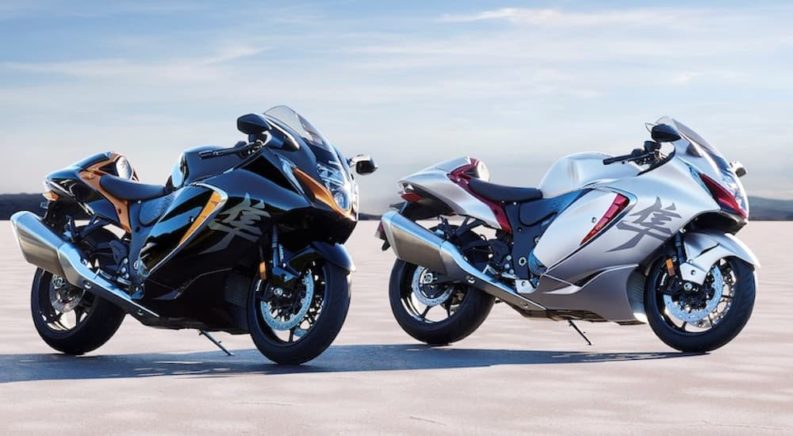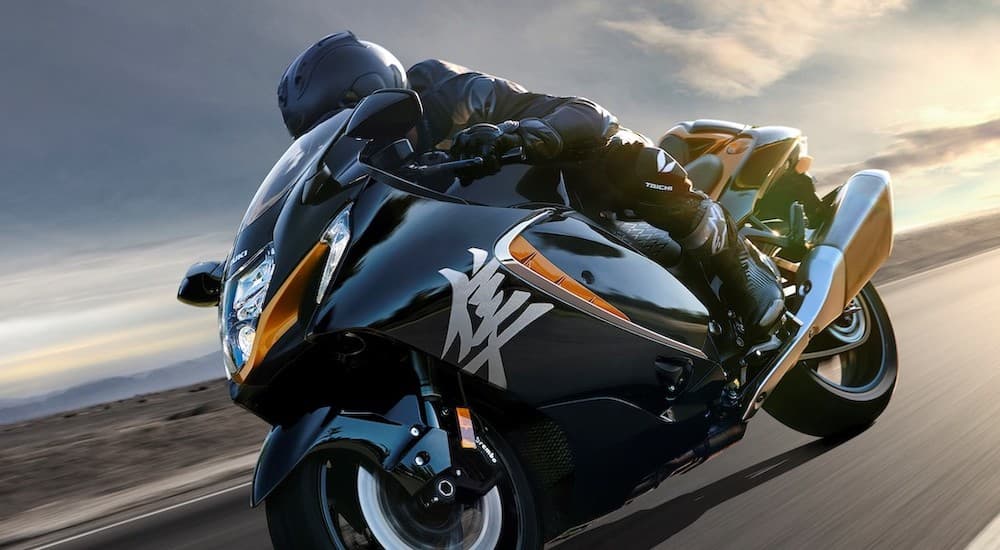Naming a motorcycle after a bird doesn’t seem all that impressive, but Suzuki didn’t name the Hayabusa after just any bird. Suzuki put some thought into it and considered what the motorcycle would mean to the industry at its debut in 1999. It deserved a name reflective of its capability, and for Suzuki, nothing embodied that characteristic more than Japan’s fastest bird: the Peregrine falcon, known to the Japanese as the Hayabusa. It is renowned for diving through the air at over 200 MPH to catch its prey with extreme precision.
The Suzuki Hayabusa debuted as the fastest production motorcycle in the world in 1999. Today, it’s one of the most sought-after new and used Suzuki motorcycles for sale because of its distinct design, legendary heritage, and all-around performance. For many, the beloved ‘Busa isn’t just about speed, but also embodies an incredible legacy and the thrill of the ride in every sense of the word.
Rivalry Breeds Ingenuity: The Legend Is Born
Competition is healthy in the motorcycle industry because manufacturers constantly seek ways to deliver more power, capability, and ingenuity. This competition came to a head in the late 1990s when Suzuki started developing a new bike that would upset the fastest production motorcycle in the world: the Honda CBR1100XX Super Blackbird. By 1999, Suzuki answered with the Hayabusa, named after the Peregrine falcon known for its speed and, probably not coincidentally, its penchant for dining on blackbirds.
Many questioned the Hayabusa’s on-road prowess because of its distinct and curvy design. It was unfamiliar in every regard, but quickly proved its looks were deceiving. The Hayabusa launched to life, reaching a top speed of 194 MPH and stealing the title as the world’s fastest production motorcycle from the Blackbird. Aptly named, indeed.
As the first road-legal bike to surpass 186 MPH, the Hayabusa established a new segment of motorcycles known as Ultimate Sport. However, no one really knew what to do with such a powerhouse, at least not at first. Its high speeds and sheer capability made it intimidating, but riders quickly discovered it handled exceptionally well at any speed because of its wide gear range. Suddenly, the Hayabusa was a fan favorite, casting the Blackbird in the shadows and sealing its fate as a legendary road warrior.
The Heart of the Warrior and A Multi-National Gentleman’s Agreement
Suzuki was determined to oust the Blackbird from its nest, knowing the Hayabusa would need an engine capable of reaching higher speeds than the infamous Honda. Knowing that bigger is always better, Suzuki developed a 1,299 cc liquid-cooled inline-four engine with 16 valves and dual-overhead camshafts. As the largest displacement Japanese motorcycle engine in the late 1990s, the Hayabusa’s heartbeat and distinct design made it a speed demon worthy of the crown. The powertrain churned out 173 horsepower, a far greater output than even some modern automobiles like the Chevy Trailblazer, Buick Encore, Kia Soul, and Nissan Versa.
While the Hayabusa’s heartbeat earned it the title of the fastest production motorcycle in the world, it also spawned another round of competition, as Kawasaki tried to oust it from the throne with the Ninja ZX-12R. While competition is often healthy, there was growing concern in the industry that this race to build the world’s fastest motorcycle wouldn’t end well, and lead to high-performance models unfit for civilian riders. Thus, the unspoken gentleman’s agreement was born, as Japanese and European automakers promised to limit the capability of their top performers to 186 MPH.
With the agreement in place, the Hayabusa had already risen to the top, which left Suzuki to look for more ways to add to its appeal. By its second generation debut in 2008, the Hayabusa introduced an even larger 1340cc engine, though governed at a top speed of 186 MPH so as not to break the agreement. With the enlarged displacement and boosted compression ratio, the next-generation Hayabusa offered even more power with an output of 187 horsepower. Everyone knew that if not for the gentleman’s agreement, the Hayabusa would resume its place as the fastest production motorcycle in the world.
With tightening emission regulations in Europe and Asia, rumors abounded that Suzuki would discontinue the Hayabusa after the 2019 model year. While the model was no longer sold in places where it would not meet the new standards, it remained available in the rest of the world, including the United States.
The Legend Today: The Third-Generation Speed Demon
Suzuki introduced the third-generation Hayabusa in 2022. This version would undergo refinements that would meet the new European and Asian emission regulations, enabling it to become a true world bike once again. It also added more appeal to the ultimate sportbike by updating its chassis without compromising its distinct design or proven powertrain. The 2023 Hayabusa continues that tradition with its torque-rich 1,340cc engine delivering a broad range of power that ensures the motorcycle performs effortlessly at any speed in any condition. This versatility is heightened by new technologies like the Suzuki Intelligent Ride System and performance-oriented features like the engine’s adjustable power delivery, launch control, Motion Track ABS, and the Combine Brake systems that give you more control over how it handles and responds.
The third-generation Hayabusa may be governed to a top speed of 186 MPH, but that doesn’t limit its appeal. With 550 new and redesigned parts, the Hayabusa gets even better with age by balancing the performance expected of an Ultimate Sportbike with comfort, style, and sheer capability. It’s the ultimate embodiment of its namesake but is legions better because it puts the dream of flying down a back road within our reach.
The Power of the ‘Busa
As it goes, we often want what we’re told we can’t have. The Hayabusa’s governed top speed of 186 MPH hasn’t hindered its popularity in the motorcycle industry. Instead, it has catapulted it to new heights with over 189,000 (and counting) models sold. Realistically, limiting how fast the Hayabusa can go isn’t an issue, since most riders won’t push the bike to those limits. Instead, they invest in a ‘Busa because they know it can get there. They don’t have to see it to believe it.
For others, investing in a Hayabusa is a puzzle of sorts. As veteran ‘Busa riders know, bypassing the governor is not rocket science, and adds another level of appeal to this incredible speed demon. Buying a Hayabusa is knowing you’re investing in an iconic motorcycle and gaining the thrill of modifying it to reach its full potential, as Suzuki intended with the original Hayabusa in 1999. It’s defying the gentleman’s agreement at the individual level without affecting Suzuki’s prominence or reputation in the industry.
The Bulbous Bird: A Japanese Speed Demon
The Hayabusa is a legend in the motorcycle industry because it represents the power of ingenuity rooted in healthy, albeit fierce, competition. While the automotive industry runs rampant with this competition, it comes in the form of Jurassic models like the Ford F-150 Raptor and Ram TRX. The motorcycle industry obviously has an affinity for birds, explicitly extremely fast birds like the Peregrine falcon that prey on blackbirds. You couldn’t ask for a more appropriate match, at least not from the saddle of an icon like the beloved and notoriously bulbous ‘Busa, the motorcycle that established a new classification of bikes and changed the entire trajectory of the industry in one fell swoop.





